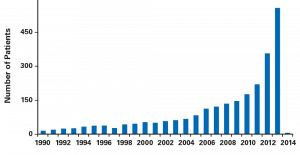Laurent Angibaud, Dipl. Ing.
Exactech, Inc.
Additive manufacturing, also known as 3D printing, is a process that creates a three-dimensional object by building successive layers of raw material, such as metal, plastic, tissue scaffolds, concrete and even food. Each new layer is attached to the previous one until the object is complete, as opposed to subtractive manufacturing methodologies, such as traditional machining. Objects are produced from a digital 3D file, such as a computer-aided design (CAD) drawing or an MRI image.
IS ADDITIVE MANUFACTURING A “NEW” TECHNOLOGY?
The first 3D printing processes were developed in the 1980s, patents were developed in the 1990s and with the first metal 3D technologies were introduced in the early 2000s. Low-cost 3D printing companies started to emerge in 2005, and the technology has grown exponentially since. In 2005, additive manufacturing was a $750 million market; today it has grown to more than $5 billion.1 The number of 3D technology manufacturers has grown from 14 in January 2012 to 431 as of September 2016.1

The application of 3D printing for orthopedic implants can provide many benefits, including: the customization and personalization of implants, cost effectiveness, increased productivity as well as the democratization of design and manufacturing.
IS ADDITIVE MANUFACTURING FOR PROTOTYPES ONLY?
This technology has moved well beyond prototyping, rapid tooling and toys. Additive manufacturing is creating durable and safe products for sale to real customers in moderate to large quantities. For example, one out of every 30 hip surgeries involves components that come from an Arcam Electron Beam Melting (EBM) system.2 Patient specific cutting blocks or pin guides are manufactured at a quantity of almost 100,000 per year.3,4 More than 10,000,000 hearing aid components have been manufactured by additive manufacturing.5
WHAT ARE THE ADVANTAGES OF ADDITIVE MANUFACTURING?
The flexibility of 3D printing allows designers to make changes easily without the need to set up additional equipment or tools. It also enables manufacturers to create devices matched to a patient’s anatomy (patient-specific devices) or devices with very complex internal structures (e.g., porous structure). An engineer can design the surgeon’s part as he or she envisions it without manufacturing constraints. This “manufacturing on demand” process streamlines the supply chain and can save hospitals on the cost of inventory. Additive manufacturing is a green technology. Because only the material that is needed is used, there is very little (if any) material wasted. These capabilities have sparked huge interest in 3D printing of medical devices.
EXACTECH EXPERIENCE WITH ADDITIVE MANUFACTURING
In 2016, Exactech confirmed the purchase of two Arcam Q10plus machines to expand its in-house manufacturing capabilities. This investment will advance Exactech’s long-term commitment to additive manufacturing technology. “Integrating the Arcam Q10plus technology into our operations will bring numerous benefits to our already robust manufacturing systems,” said Raymond Cloutier, Exactech vice president of engineering & development for spine. “In 2010, Exactech became the first company to receive FDA clearance for a 3-D printed orthopaedic implant and has since received multiple additional clearances for other implants. We will now be able to leverage this knowledge and experience to enhance the design of our hip, knee, extremities and spine implants, reduce product development lead times and further supplement supply.” The Arcam Q10plus is Arcam’s latest Electron Beam Melting (EBM) machine that has been designed specifically for cost-efficient production of orthopaedic implants. Studies have shown that build times can be reduced up to 25 percent with improved surface finishes, compared to previous generations of EBM systems.6 “Exactech was the first company in the U.S. to mass-produce medical implants using additive manufacturing. We are happy to see their confidence in our EBM technology and in the Arcam Q10plus as a volume production system for the medical device industry. We truly look forward to partnering with Exactech to grow production of their joint restoration products,” said Arcam Chief Executive Officer Magnus René.
WHAT ARE THE LIMITATIONS?
The application of 3D printing for orthopedic implants can provide many benefits, including: the customization and personalization of implants, cost-effectiveness, increased productivity as well as the democratization of design and manufacturing.
However, it should be cautioned that despite recent significant and exciting medical advances involving 3D printing, notable scientific and regulatory challenges remain and the most transformative applications for this technology will need time to evolve. Design complexity makes post process inspection and qualification challenging. The FDA has cleared more than 85 3D printed medical devices, but from a Regulatory perspective, it is difficult to keep up with the pace of this fast-moving technology.
The additive manufacturing process occurs “layer by layer”; which introduces anisotropy in mechanical properties resulting in high strength in the transverse plane, but lower strength along the vertical axis. This aspect is mainly a concern for small implant under substantial loading.
An engineer can design the surgeon’s part as he or she envisions it without manufacturing constraints.
CONCLUSION
Additive manufacturing is both the present and the future. It is likely to have an enormous impact on all our lives, but that doesn’t mean it is going to be good for every business. As the technology continues to evolve, the orthopaedic industry will be paying attention to its benefits as well as its limitations.
References
1. Espen Sivertsen. A Brief History of Additive Manufacturing. www.typeamachines.com
2. Michael Petch. 3D Printing Metal Interview with Arcam CEO Magnus René. www.3dprintingindustry.com
3. Thienpoint E et al. Patient-specific instruments: industry’s innovation with a surgeon’s interest. Knee Surg Sports Traumatol Arthrosc. 2013 Oct;21(10):2227-33
4. Gabelli & Company, Inc. Inside 3D printing conference and industry review. www.gabelli.com
5. Rakesh Sharma. The 3D Printing Revolution You Have Not Heard About. www.forbes.com
6. Data on file at Arcam
